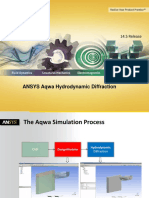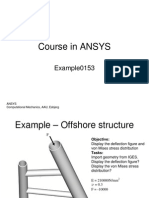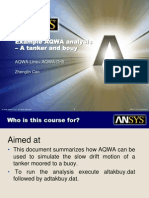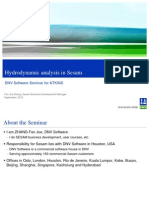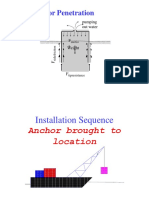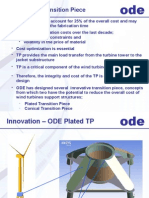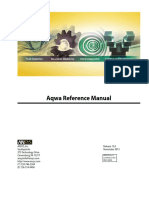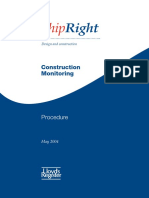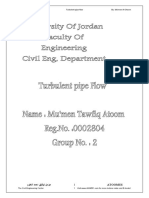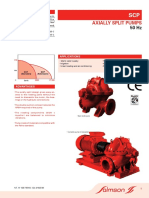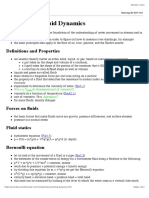0 ratings0% found this document useful (0 votes)
279 viewsAqwa-Intro 16.0 L06 SlenderBodyDragLinearization
Aqwa-Intro 16.0 L06 SlenderBodyDragLinearization
Uploaded by
Yong KimAqwa-Intro 16.0 L06 SlenderBodyDragLinearization
Copyright:
© All Rights Reserved
Available Formats
Download as PDF, TXT or read online from Scribd
Aqwa-Intro 16.0 L06 SlenderBodyDragLinearization
Aqwa-Intro 16.0 L06 SlenderBodyDragLinearization
Uploaded by
Yong Kim0 ratings0% found this document useful (0 votes)
279 views10 pagesAqwa-Intro 16.0 L06 SlenderBodyDragLinearization
Copyright
© © All Rights Reserved
Available Formats
PDF, TXT or read online from Scribd
Share this document
Did you find this document useful?
Is this content inappropriate?
Aqwa-Intro 16.0 L06 SlenderBodyDragLinearization
Copyright:
© All Rights Reserved
Available Formats
Download as PDF, TXT or read online from Scribd
Download as pdf or txt
0 ratings0% found this document useful (0 votes)
279 views10 pagesAqwa-Intro 16.0 L06 SlenderBodyDragLinearization
Aqwa-Intro 16.0 L06 SlenderBodyDragLinearization
Uploaded by
Yong KimAqwa-Intro 16.0 L06 SlenderBodyDragLinearization
Copyright:
© All Rights Reserved
Available Formats
Download as PDF, TXT or read online from Scribd
Download as pdf or txt
You are on page 1of 10
At a glance
Powered by AI
The document discusses modeling slender bodies and linearizing drag forces using Aqwa software.
Aqwa can model slender bodies by assuming there are no interference effects on the approaching wave and that loading can be described by a formula including added mass and drag effects.
The Morison equation calculates hydrodynamic forces on slender cylindrical elements using element diameter, relative velocity, added mass and drag coefficients, and element properties. It represents the Froude-Krylov and wave inertia terms.
Lecture 6:
Aqwa Slender Body Modelling and Drag
Linearization 16.0 Release
Introduction to Hydrodynamic Analysis with ANSYS Aqwa
1 2015 ANSYS, Inc. July 23, 2015
Aqwa Slender Body Modelling
In the previous lectures and workshops we have
only looked at structures with a significant volume
displacement that requires the utilization of panel
elements to include the effects of wave diffraction
and radiation effects.
Aqwa can also include slender bodies, where it is
assumed that there will be no interference effects
on the approaching wave, and that loading can be
described in a simple formula that includes both
viscous drag and added mass effects.
2 2015 ANSYS, Inc. July 23, 2015
Morison Elements
In lecture 2 we introduced the computation of hydrodynamic forces on non-diffracting
structures, modelled with Morison elements (TUBE, STUB and DISC)
For slender cylindrical elements (D/<0.2), e.g. tube elements, the hydrodynamic force
(including drag) per unit length can be calculated using the Morison equation:
1 C DV V
F aw Ca aw Ca X d
2
aw and X are the accelerations of the flow and the body, respectively;
Ca and Cd are the added mass and drag coefficients of the element;
V is the relative velocity between the flow and the body;
is the volume of the element (per unit length);
D is the element diameter;
is the wave length.
The Froude-Krylov and wave inertia terms are sometimes combined and written in terms
of the inertia coefficient, Cm = 1 + Ca
3 2015 ANSYS, Inc. July 23, 2015
Morison Elements
While the diffraction elements provide a linear solution to the wave frequency loading, the
Morison elements include the viscous drag effects which are non-linear. For frequency
domain solutions we need to consider how to include these effects in a linear fashion.
In both the radiation/diffraction analysis and frequency statistical analysis the linearization
is undertaken for a specific spectrum.
Note that in the HD system, while the modified RAOs may be reported and plotted, they
are NOT stored on the hydrodynamic database for use in any subsequent analysis. Likewise
the QTFs are not re-computed.
4 2015 ANSYS, Inc. July 23, 2015
Drag Linearization in Diffraction Analysis
5 2015 ANSYS, Inc. July 23, 2015
Calculations
In the calculation of drag force V.|V| is a non-linear term in which the |V|
can be replaced by a factor multiplied by the r.m.s. velocity in order to create
an equivalent linear term.
In the literature (Borgman 1967) this factor is given as (8/). We thus get
Full Drag Force = ..A.Cd .V.|V|
Linearized Drag Force = ..A.Cd ..Vrms .V
where V = relative fluid velocity
and = (8/)
Vrms is calculated using a defined spectrum. As V is relative velocity the
calculation is iterative.
6 2015 ANSYS, Inc. July 23, 2015
Calculations
Modified RAO equation
[-2 {M()+MS} i {C() + CDL() }+ K ] X(,) = FD(,) + FK(,) + FDL(,)
Calculate:
RAOs
relative velocity for each component of the spectrum
rms velocity
drag coefficients
new RAOS check for convergence
7 2015 ANSYS, Inc. July 23, 2015
Calculations
When current is included, we assume that the linearization factor is in the form
= [ (*Vrms)2 + Vc2 ]
Where = 2 [ 2 e-r ]
r = Vc/( Vrms)
Found by numerical investigation of the error in dissipation of drag energy
8 2015 ANSYS, Inc. July 23, 2015
Additional Drag Linearization Functionality
In a frequency statistical analysis, further drag
linearization may be included in the
simulation
Current hull drag
Wind drag
Dynamic cables
With the exception of dynamic cables, drag
linearization is requested by setting the
Linearized Morison Drag option in the analysis
settings. When cable dynamics is employed,
drag linearization for the cables is always
applied.
9 2015 ANSYS, Inc. July 23, 2015
Workshop 6.1 Aqwa Slender Body Modelling
Workshop 6.1 Slender Body and Drag Linearization
Goal:
Create a model containing both diffraction and slender
body components and investigate the effects in the
frequency and time domains.
10 2015 ANSYS, Inc. July 23, 2015
You might also like
- Wamit V6.4: Diffraction-Radiation ComputationDocument66 pagesWamit V6.4: Diffraction-Radiation ComputationAnonymous JEe6LWPNo ratings yet
- Workshop 03.1: Aqwa Basics - Hydrodynamic ResponseDocument37 pagesWorkshop 03.1: Aqwa Basics - Hydrodynamic ResponseSahil Jawa100% (1)
- A3 GeniE Tubular JointDocument60 pagesA3 GeniE Tubular JointFabio OkamotoNo ratings yet
- Design of A Truss SparDocument61 pagesDesign of A Truss SparEduardo SanchezNo ratings yet
- Vedeld 2 - VIV Fatigue CalculationDocument36 pagesVedeld 2 - VIV Fatigue Calculationmobin_turkNo ratings yet
- Introduction To ANSYS Aqwa: Customer Training MaterialDocument2 pagesIntroduction To ANSYS Aqwa: Customer Training MaterialGustavo MaldonadoNo ratings yet
- Offshore Mechanics: Structural and Fluid Dynamics for Recent ApplicationsFrom EverandOffshore Mechanics: Structural and Fluid Dynamics for Recent ApplicationsNo ratings yet
- Free Fall Experiment DiscussionDocument5 pagesFree Fall Experiment DiscussionAnonymous iJOQiAIvPT40% (5)
- Ansys Aqwa - An Integrated SystemDocument16 pagesAnsys Aqwa - An Integrated SystemRini MathewNo ratings yet
- Aqwa-Intro 14.5 WS02.1 AqwaWB HDDocument59 pagesAqwa-Intro 14.5 WS02.1 AqwaWB HDMisael Oré100% (3)
- Lecture 07-Aqwa-Mechanical Load Mapping For A Transport BargeDocument13 pagesLecture 07-Aqwa-Mechanical Load Mapping For A Transport BargeCarlos Garrido100% (1)
- Aqwa-Intro 14.5 L05 Load Mapping PDFDocument16 pagesAqwa-Intro 14.5 L05 Load Mapping PDFdesignhub152No ratings yet
- ANSYS AQWA For Hydrodynamic AnalysisDocument28 pagesANSYS AQWA For Hydrodynamic AnalysisZulham MochtarNo ratings yet
- Aqwa-Intro 14.5 L01 Introduction PDFDocument32 pagesAqwa-Intro 14.5 L01 Introduction PDFksangeeth2000No ratings yet
- EN8000 Aqwa Tutorial: Aqwa-Line Aqwa-Fer Aqwa-Librium Aqwa-Drift Aqwa-NautDocument13 pagesEN8000 Aqwa Tutorial: Aqwa-Line Aqwa-Fer Aqwa-Librium Aqwa-Drift Aqwa-NautDani GarciaNo ratings yet
- Aqwa-Intro 14.5 WS02.1 AqwaWB HDDocument59 pagesAqwa-Intro 14.5 WS02.1 AqwaWB HDAna T100% (2)
- ANSYS Aqwa Hydrodynamic Time ResponseDocument29 pagesANSYS Aqwa Hydrodynamic Time ResponsePhúc Phan Tử100% (11)
- Ansys Example 0153 Offshore StructureDocument38 pagesAnsys Example 0153 Offshore StructureMohammed Abd El Rahman100% (2)
- 02AQWA Example C A Tanker and BouyDocument45 pages02AQWA Example C A Tanker and BouySyed HasanNo ratings yet
- Aqwa Programs Tutorial-2Document17 pagesAqwa Programs Tutorial-2Syed Hasan100% (1)
- FEA Buckling AnalysisDocument10 pagesFEA Buckling AnalysisalexrodriguezabcNo ratings yet
- 1.d. Overall Damping For Piled Offshore Support StructuresDocument4 pages1.d. Overall Damping For Piled Offshore Support StructuresShokoofeAlaviNo ratings yet
- Validation of Spectral Fatigue Analysis of Structures in Mumbai High FieldDocument34 pagesValidation of Spectral Fatigue Analysis of Structures in Mumbai High FieldNripendra MishraNo ratings yet
- ANSYS Offshore Products 14-0 Update - SchofieldDocument44 pagesANSYS Offshore Products 14-0 Update - SchofieldZhiqiang GuNo ratings yet
- Thesis Report Koen Van Koten 4207785 Offshore Dredging EngineeringDocument93 pagesThesis Report Koen Van Koten 4207785 Offshore Dredging EngineeringYavuz Selim DEMİRELNo ratings yet
- (ANSYS AQWA) Study On Mooring System Design of Floating Offshore Wind Turbine in Jeju Offshore AreaDocument9 pages(ANSYS AQWA) Study On Mooring System Design of Floating Offshore Wind Turbine in Jeju Offshore AreaychodnekerNo ratings yet
- Finite Element Modeling of Suction CaissonDocument179 pagesFinite Element Modeling of Suction Caissonjoejo_s_hotmail100% (1)
- Suction Caissons For Wind TurbinesDocument20 pagesSuction Caissons For Wind TurbinesSuraparb KeawsawasvongNo ratings yet
- Sesam Webinar - Complete Structural Analysis For Floating OWT - QA - tcm8-105379Document9 pagesSesam Webinar - Complete Structural Analysis For Floating OWT - QA - tcm8-105379samiransmitaNo ratings yet
- AQWADocument20 pagesAQWAG Sri SoumyaNo ratings yet
- Pushover Analysis Guide: Ultimate Strength Analysis of A Typical New North Sea Jacket Structure Using ABAQUSDocument16 pagesPushover Analysis Guide: Ultimate Strength Analysis of A Typical New North Sea Jacket Structure Using ABAQUSN TNo ratings yet
- Mooring Analysis of A Subsea Pipelay Barge: Kamal Singh Yadav, Savin Viswanathan, Arunprasath PDocument12 pagesMooring Analysis of A Subsea Pipelay Barge: Kamal Singh Yadav, Savin Viswanathan, Arunprasath PaaNo ratings yet
- Sesam Hydrodynamics Training Oct 2012Document374 pagesSesam Hydrodynamics Training Oct 2012abhinavka123No ratings yet
- Mesh-Intro 15.0 WS 07d Assembly MeshingDocument26 pagesMesh-Intro 15.0 WS 07d Assembly MeshinghaziqNo ratings yet
- Lateral Loading of Suction Pile in 3D 1488918612Document35 pagesLateral Loading of Suction Pile in 3D 1488918612mohamed magdyNo ratings yet
- Calculation Sheet: LQ Module Roof Deck Primary Beam - Lifting Point A1 1. Data & AssumptionDocument12 pagesCalculation Sheet: LQ Module Roof Deck Primary Beam - Lifting Point A1 1. Data & AssumptionWistie Annelya100% (1)
- Anchor Penetration: Pumping Out WaterDocument12 pagesAnchor Penetration: Pumping Out Watergamidi67No ratings yet
- Mathcad - Grout Connection HSE RulesDocument3 pagesMathcad - Grout Connection HSE RulesRayodcNo ratings yet
- PLated Transition Piece and ComparisonDocument11 pagesPLated Transition Piece and ComparisonWangwen ZhaoNo ratings yet
- Nermical Modelling of Laterally Loaded Piles For Offshore Wind TurbinesDocument244 pagesNermical Modelling of Laterally Loaded Piles For Offshore Wind TurbinesXiang ming GeNo ratings yet
- Spectral Fatigue Flow Chart PDFDocument1 pageSpectral Fatigue Flow Chart PDFChinnaraja GandhiNo ratings yet
- Specialists in Site Specific AssessmentDocument4 pagesSpecialists in Site Specific AssessmentAhmed ElkhoulyNo ratings yet
- Orca Flex 1Document376 pagesOrca Flex 1autienhaiNo ratings yet
- Wamit ManualDocument343 pagesWamit ManualAlberto darianNo ratings yet
- OrcaFlex Demonstration IIT MadrasDocument11 pagesOrcaFlex Demonstration IIT MadrasvigambetkarNo ratings yet
- AQWA Reference ManualDocument272 pagesAQWA Reference ManualGustavo MaldonadoNo ratings yet
- Splash Zone Lifting Analysis of Subsea StructuresDocument11 pagesSplash Zone Lifting Analysis of Subsea StructuresAnonymous PibYPgh100% (1)
- Wave LoadingDocument10 pagesWave Loadingmyusuf_engineerNo ratings yet
- Orca FlexDocument9 pagesOrca FlexThis ManNo ratings yet
- A Study On Fatigue CharacteristicsDocument6 pagesA Study On Fatigue CharacteristicsRashed Kaiser100% (1)
- The Modelling of Suction Caisson Foun-Dations For Multi-Footed StructuresDocument172 pagesThe Modelling of Suction Caisson Foun-Dations For Multi-Footed StructuresNguyen Thanh Duc BKNo ratings yet
- PISA I - Final ReportDocument272 pagesPISA I - Final ReportRituraj Singh SujawatNo ratings yet
- DNV-CN 31.4 - Column Stabilized UnitsDocument94 pagesDNV-CN 31.4 - Column Stabilized Unitsdjodje1No ratings yet
- Generalized Wave Parameter For Rules Formulae: September 2016Document9 pagesGeneralized Wave Parameter For Rules Formulae: September 2016Youngkook KimNo ratings yet
- Development of Time-Domain VIV Prediction and Analysis ToolDocument19 pagesDevelopment of Time-Domain VIV Prediction and Analysis ToolNguyen ThangNo ratings yet
- Bihs - 6DOF LSM REEF3D - IJNMF 2017Document17 pagesBihs - 6DOF LSM REEF3D - IJNMF 2017Arjun VinodNo ratings yet
- Investigation of Transonic Aerodynamics On A Triple-Delta Wing in Side Slip ConditionsDocument18 pagesInvestigation of Transonic Aerodynamics On A Triple-Delta Wing in Side Slip Conditionstharakaram973No ratings yet
- Rail ResistanceDocument14 pagesRail Resistancehalf2lifer100% (1)
- CFD Assignment 2D Incompressible FlowDocument25 pagesCFD Assignment 2D Incompressible FlowPraphulNo ratings yet
- Shape Optimization of An Autonomous Underwater Vehicle With A Ducted Propeller Using Computational Fluid Dynamics AnalysisDocument13 pagesShape Optimization of An Autonomous Underwater Vehicle With A Ducted Propeller Using Computational Fluid Dynamics AnalysishanstiwariNo ratings yet
- Motion Analysis Offer Superb Support On BoardDocument25 pagesMotion Analysis Offer Superb Support On BoardJorge Del RioNo ratings yet
- LR - Construction Monitoring Procedure PDFDocument30 pagesLR - Construction Monitoring Procedure PDFYong KimNo ratings yet
- LR - SDA Procedure PDFDocument47 pagesLR - SDA Procedure PDFYong KimNo ratings yet
- 1 - Ref - Drilled and Grouted Piles For TLP FoundationDocument147 pages1 - Ref - Drilled and Grouted Piles For TLP FoundationYong KimNo ratings yet
- Trelleborg Engineered Products Bearing Product BrochureDocument14 pagesTrelleborg Engineered Products Bearing Product BrochureYong KimNo ratings yet
- 1 WSF Risk Management PlanDocument7 pages1 WSF Risk Management PlanYong Kim100% (1)
- 1 - IFC - EHS Guidelines For ShippingDocument18 pages1 - IFC - EHS Guidelines For ShippingYong KimNo ratings yet
- 1 - Smart RBI Program For LNG Plant SystemDocument22 pages1 - Smart RBI Program For LNG Plant SystemYong KimNo ratings yet
- 1 - Cryogenic Submerged Electric Motor PumpsDocument2 pages1 - Cryogenic Submerged Electric Motor PumpsYong KimNo ratings yet
- 1 - Side by Side Mooring AnalysisDocument11 pages1 - Side by Side Mooring AnalysisYong KimNo ratings yet
- Phys 201Document9 pagesPhys 201John HamiltonNo ratings yet
- Flow and Heat Transfer of A Power-Law Fluid Over A Permeable Shrinking SheetDocument6 pagesFlow and Heat Transfer of A Power-Law Fluid Over A Permeable Shrinking SheetHendarNo ratings yet
- Chapter 4: Basic Equations in Integral Form For A Control VolumeDocument40 pagesChapter 4: Basic Equations in Integral Form For A Control VolumeMarkgil ManalansanNo ratings yet
- UNIT2DDocument23 pagesUNIT2Dapi-3699866No ratings yet
- Inclined Plane Experiment NewestDocument3 pagesInclined Plane Experiment Newestapi-238942037No ratings yet
- Hydraulics TerminologiesDocument3 pagesHydraulics TerminologiesKrisleen Elyzel GullasNo ratings yet
- Pressure Drop Calculation For Thick Sqaure Plate OrificeDocument2 pagesPressure Drop Calculation For Thick Sqaure Plate OrificeGieNo ratings yet
- Pipe LossesDocument30 pagesPipe LossesAbdullah ButtNo ratings yet
- Chapter Two Introductory Concept To Compressible FlowDocument10 pagesChapter Two Introductory Concept To Compressible FlowAli SabahNo ratings yet
- Chapter 7Document28 pagesChapter 7lockas222No ratings yet
- Variation of Which Is Given by The Moody Diagram As:: V RS NDocument3 pagesVariation of Which Is Given by The Moody Diagram As:: V RS NSathyamoorthy Venkatesh100% (1)
- 7.turbulent Pipe Flow - Set 2Document5 pages7.turbulent Pipe Flow - Set 2ahm531No ratings yet
- Igcse Physics Forces MovementDocument6 pagesIgcse Physics Forces Movementapi-255623302No ratings yet
- Pump De-Rated PerformanceDocument4 pagesPump De-Rated PerformanceField Marshal Thebe HanyaneNo ratings yet
- Ad 01202010214Document14 pagesAd 01202010214theijesNo ratings yet
- Aerodynamics 2Document60 pagesAerodynamics 2ajay rNo ratings yet
- Microfluidics Endsem 2015-NPTELDocument2 pagesMicrofluidics Endsem 2015-NPTELRoy BrothersNo ratings yet
- WILO SCP RangeDocument48 pagesWILO SCP RangeSaikat PurkaitNo ratings yet
- Lesson 5Document53 pagesLesson 5MARY GRACE B. BACASONNo ratings yet
- Principles of Fluid DynamicsDocument2 pagesPrinciples of Fluid DynamicsMicheleFontanaNo ratings yet
- 00 Box CV (Box Wider Than Canal)Document1 page00 Box CV (Box Wider Than Canal)Jeff L DjambakNo ratings yet
- Head Loss From Rapid Sand Filter To Clear Water TankDocument3 pagesHead Loss From Rapid Sand Filter To Clear Water TankNaungNo ratings yet
- ME Course ContentsDocument55 pagesME Course ContentsSWAGATAM BAZNo ratings yet
- (Diff. P) 2021, Netherlands - Hydraulic Insights Into Rapid Sand Filter Bed Backwashing Using The Carman-Kozeny ModelDocument12 pages(Diff. P) 2021, Netherlands - Hydraulic Insights Into Rapid Sand Filter Bed Backwashing Using The Carman-Kozeny ModelMi doremiNo ratings yet
- Forces-2Document9 pagesForces-2Gracious SakaNo ratings yet
- ARET 3400 - Chapter 4Document30 pagesARET 3400 - Chapter 4Harald JungkimNo ratings yet
- Assignment 3 Report CFDDocument51 pagesAssignment 3 Report CFDJack Hughes100% (1)
- PHY106 Finals Lesson 5Document11 pagesPHY106 Finals Lesson 5Temothy Earl UrmenitaNo ratings yet
- GopalarathnamEtal 2003 JofAC LRNAirfoiLDesignWithTrips 1Document8 pagesGopalarathnamEtal 2003 JofAC LRNAirfoiLDesignWithTrips 1Khemissat BoualemNo ratings yet









